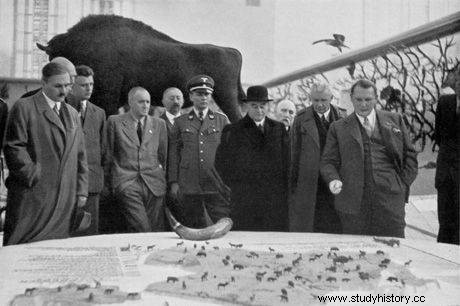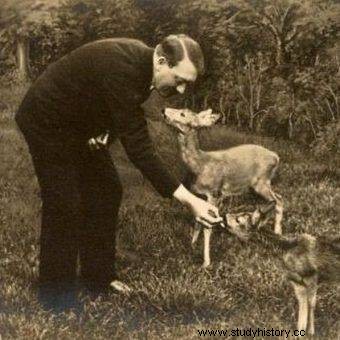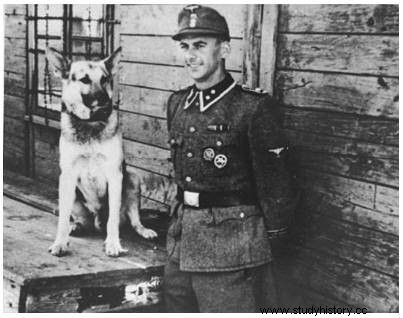The prohibition of vivisection and experimentation, humane slaughter methods, the protection of endangered species, restrictions for hunters, close relationships with domestic pets and a vegetarian diet - this is how the Nazis cared for animals. Hitler even intended to liquidate slaughterhouses throughout the Reich and force his fellow citizens to become vegetarian.
A corpse on a plate, bull balls on a prescription
Much has been written about Adolf Hitler's vegetarianism. Some biographers claim that Hitler followed a (though not always orthodox) vegetarian diet while others claim that the myth of the Fuhrer's vegetarianism is one of the greatest achievements of Joseph Goebbels' masterly propaganda.
Even those historians who take the position that Hitler actually gave up meat (or severely limited it) do not agree, however, as to the reasons behind this decision. According to one theory, he had health reasons for this, another hypothesis gives the cause of his niece's suicide, and yet another is ethical.
Goebbels wrote about ethical reasons, emphasizing that Hitler was a staunch vegetarian, considered eating meat as evidence of social decline and wanted to proceed after the war to revolutionize the food production system, so that the entire German nation could ultimately benefit from the beneficial effects of a meatless diet. Supposedly, in 1941, Hitler said that if he was to try to judge anything about the future, he was sure of one thing - the future belongs to vegetarians . He also did not believe that humans had grounds for elevating themselves above other creatures. Goebbels presented Hitler's arguments in his journals as follows:
The human thinks that only he has mind, soul and speech, and the animal does not. The fact that we do not recognize it with our blunt senses does not prove that it does not exist.
Apparently, during a dinner with a lady, he commented on the fact that she had ordered sausages, asking her if she was really going to eat the corpse. On the other hand, the Führer's physician, Teodor Morell, administered to him numerous "miraculous", largely animal preparations that were to improve the health and form of the nation's leader , extend his life and ease the hardships of the authorities.
Crisis kitchen
So was Hitler's vegetarianism merely a propaganda exercise aimed at creating the proper image of the leader? Perhaps. As the nation's elite, Hitler and his closest officials could afford to give up meat to emphasize their status.
It was also possible to show solidarity with the nation during the economic crisis - in 1933 the NSDAP called on the Germans to eat a "crisis" one-pot dish instead of a hearty lunch every first Sunday of the month ( eintopf ) - or a decade later, when the regime had to announce to citizens about the shrinking rationing rationing of meat. The Führer himself was fond of one-pot dishes, so he did not have to make any sacrifices - and the citizens had to reckon with the fact that in the event of a deviation, their party comrades would visit them, who "on Sunday sniffed in the corridors of houses for the smell of frying and, if they discovered it, exhorted them to eintopf solidarity. "- writes Hitler's biographer, Peter Longerich.

The text was created, among others for a book by the bestselling author Christopher Mack, "Goebbels Confession. A sincere conversation with a friend of Hitler ”, which has just been released by the Bellona publishing house. Buy now
From the very beginning, the party looked into the pots of citizens, and the leader, according to Goebbels, wished to completely ban slaughterhouses in the Reich after the end of the war. His constituents, of course, did not know about this, and Goebbels, who had been diligently performing his tasks as the minister of propaganda since 1928, persuaded to vote for Hitler wherever it fell - apparently it did not matter for the Führer whether he was supported by a nation of carnivores or vegetarians as long as he could stay in power. As we read in Goebbels' Confession:
It's true that you sent your people to meat stores, bakeries and workplaces to ask citizens who they voted for and convince them that the only right choice was Adolf Hitler?
- Oh yeah! It happened so many times. And I think it worked because I was building a myth of a leader that all people would follow.
"Green" Nazis in the fight for animal rights
Meanwhile, long before the NSDAP and Hitler took power, changes to the law governing the protection of animals were being prepared. In 1927, the Reichstag called for steps to be taken to counter the suffering of animals that resulted from kosher slaughter. In 1932, the Nazi party proposed a ban.
In August 1933, Hermann Goering announced that he was about to put an end to "the unbearable torture and suffering of animals undergoing experiments," and would place anyone who "still thinks they can treat animals like objects" in concentration camps . In his radio speech he said:
For the German people, animals are not just living organic matter, but creatures endowed with individual feelings, feeling pain and joy, showing loyalty and devotion. Our nation's love for animals would never allow us to treat them as objects without feeling and soul, to use them like tools are used, to use and throw away - for whatever the reasons, nor to torture or kill them .
From August 16, 1933, vivisection was strictly forbidden in Prussia, as was ritual slaughter without stunning (which, of course, was aimed primarily at Jewish religious orders), and in November 1933, new regulations came into force in the Reich, according to which the experiments on animals, they were subject to a number of prohibitions, they needed special permits and recommendations, which - as it is not difficult to guess - left a lot of room for Nazi doctors and vets to act.
Cathedral of God
Importantly, horses, dogs, cats and monkeys were listed as deserving special protection. Domestic animals enjoyed special protection - for bad treatment of a dog or a cat, one could spend two years in prison and pay a heavy fine.
The new law regulated almost all activities that animals were subjected to - from shoeing horses and trimming dogs' ears or tails, through the participation of animals in film productions, to the use of anesthetics and euthanasia of terminally ill pets.
In 1936 even lobsters and crabs were protected:restaurants were to stop killing crustaceans by throwing them into boiling water . The authorities reportedly debated the most humane method of killing lobsters for a long time, and there were even scientific studies on this subject. The production of foie gras was also banned .
The Nazis also turned their attention to the protection of wildlife. It began with a change to the hunting law in March 1935; the following paragraph appeared in the preface to the document:"The duty of a true hunter is not only to hunt, but also to care for the welfare of wild animals, feed them and care for them."

Lutz Heck (first from the left) and Herman Goering (first from the right) above the model of the Białowieża Forest during the International Hunting Exhibition in 1937.
In an effort to ensure the survival of wildlife (in its strongest, healthiest form, of course), veterinary journals have often published texts on endangered species. Goering himself, who used to say that "the forest is the cathedral of God", worried that in Germany bears and bison had been almost completely exterminated and therefore he tried to put them under protection and to launch programs to increase their numbers. Thanks to him, elk also returned to German forests. He also founded nature reserves that are still in operation today.
Professor Ian Kershaw, author of Hitler's biography, noted that the Nazis paradoxically had ethical intentions in introducing animal rights laws, including prohibiting fox hunting with dogs. "The Nazis wanted to kill cleanly and believed it was wrong to inflict excessive suffering on animals while hunting," he wrote. - "It was believed that such behavior was contrary to the spirit and feelings of the German people." Interestingly, the regulations introduced by the National Socialist party in the 1930s were the most complete and broadest at that time - no other country could match the Reich in this respect.
Love (only) for animals
How to reconcile the Nazi protection of animals and the love of pets as well as crimes against humanity and cruelty towards one's neighbor? Well, depends on which side of the camp fence you are on . In the minds of the Nazis, both issues seemed to exist without contradiction. Moreover, they felt the moral elite of the nation . Animals were perceived in a variety of ways, as Jan Mohnhaupt, author of Tiere im Nationalsozialismus writes. ( Animals in the ideology of National Socialism ):sometimes as an ideal of strength and courage (wolf, lion), sometimes as an image of an enemy (pig), and sometimes only as a means to an end.
Hitler did not part with his German Shepherd bitch, Blondi, who slept in his bed with him, and Goering kept young lions as pets. Goebbels also had a beloved dog to which he was very attached. As we read in Goebbels' Confession:
It was probably in 1942. Then I went with my wife for a few days to the biennale to Venice, to experience a bit of culture. And I remember that at a meal I made a joke that I missed my home and that if I could make my dream come true now, I would like my dog, who stayed in the Third Reich, to come here.
- Did you mean that for real?
- Not exactly. More like half a joke, half seriously. However, apparently my surroundings did not sense it and decided to prove it. The further development was that they put that poor dog on a plane in the hold and some guy flew over to me with him. As soon as I saw it, I was furiously furious! How could such a thing happen? After all, this poor animal must have stressed more than anyone else. Later that day I ordered to send the pooch home.

It is believed that one of the reasons Hitler restricted meat-eating was his love of animals
Goebbels also liked to boast about the Berlin Zoo:“we care for this zoo” - he emphasized. He was friends with the director of the facility, visited the zoo several times with his wife and children, who played with gentler animals such as deer, swans and ducks. At that time, it was a place where people tired of their work could go for a lunch break, "rest and have fun", wrote Karl Koch, commandant of the Buchenwald camp, who ran the facility largely thanks to the money stolen from prisoners. Of course, prisoners or forced laborers who erected fences or looked after the animals were not allowed to be entertained or rest. The commandant had the best fun watching the bears tearing apart the inmates.
The Dogs of War
Another issue was the presence of dogs in the camps, which Himmler had instructed so that they could "tear a man to shreds" on command. He believed that one well-trained dog is worth two human guards.
One of the people responsible for training guard dogs in Dachau and Buchenwald was Paul Henss, who told reporters in an interview many years after the war that the accusations against himself were unfair and he was by no means considered a criminal:"When someone ran away the dogs were going to catch him. So they were taught. ” This former member of the NSDAP volunteered to work as a camp guard in Dachau and Buchenwald, where he was in charge of training and supervision of dogs in 1942-1944, and after the war - in 1955 - he moved to the States, where he hid his past for many years (in his old age he earned a living from the state benefit). In 2007, the authorities wanted to deport him, but decided to return to Germany.
How many dogs served the Nazis in the Third Reich? According to researchers, tens of thousands. During World War II, and thus also in the camps, according to criminologists J. Robert Lilly and Michael B. Puckett, at least 200,000 people worked. trained dogs . The accounts of the survivors who survived the hell of the camps agree on this point - dogs were used to terrorize prisoners rather than maintain order - and not only by ordinary guards.

How many dogs served the Nazis in the Third Reich? Tens of thousands according to researchers.
An example is Otto Moll, called the "Cyclops" because of his artificial eye, one of the worst SS men in Auschwitz, the manager of the crematoria. His long list of degenerate behavior includes releasing his German Shepherd Dog against pretty young Jewish women.
Sources and accounts agree that terrorizing prisoners in this way was part of the camp routine from the moment they arrived until they were pushed into gas chambers, shot or sentenced to long, slow death by starvation, disease or inhuman experiments. . Hitler's female dog, Blondi, was more fortunate - the Führer handed her a cyanide capsule before committing suicide. Her five puppies were shot shortly after the deaths of Hitler and Eva Braun.
Bibliography:
- Arluke, B. Sax, Understanding Nazi Animal Protection and the Holocaust , Anthrozoös, 5:1, 6-31,1992.
- Irving, Goering - a Biography , New York 1989.
- Sax, Animals in the Third Reich , Pittsburg 2000.
- Höss, Death Dealer:The Memoirs of the SS Kommandant at Auschwitz , trans. A. Pollinger, Buffalo 1992.
- Mohnhaupt, Tiere im Nationalsozialismus , Munchen 2010.
- Longerich, Hitler. Biography , crowd. M. Antkowiak, Warsaw 2020.
- Irving, Hitler's Doctor's Secret Journals , crowd. B. Zborski, Pruszków 1999.
- Bolton, Animal Welfare in the Third Reich , London 2010.
- Bruce, Throught the Lion Gate. A history of the Berlin Zoo , New York 2017.
